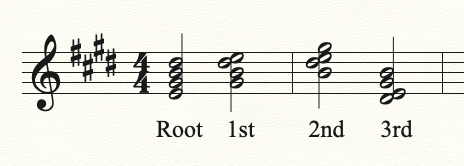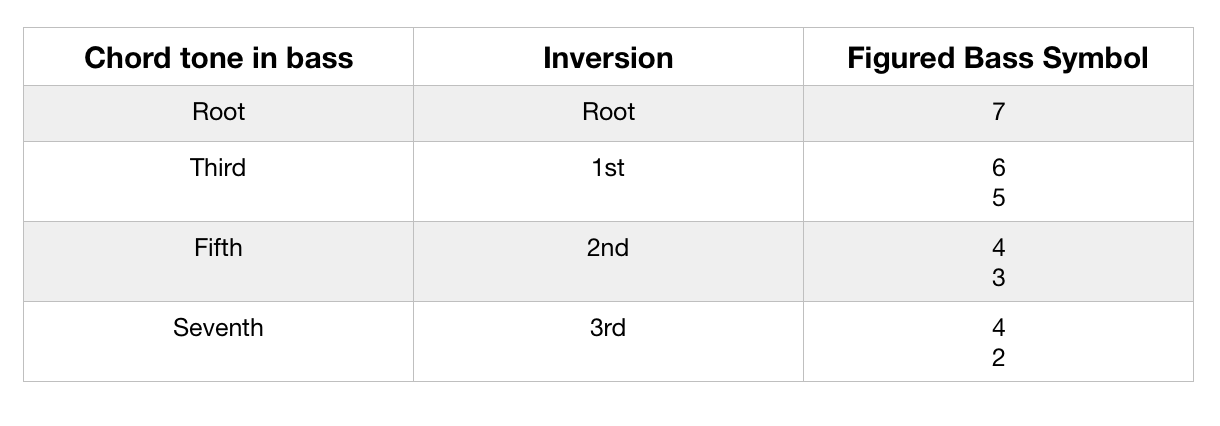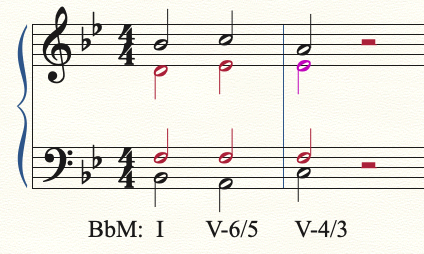Browse By Unit
3.5 Seventh Chord Inversions and Figures
6 min read•june 18, 2024
Just like in triads, seventh chord inversions are chords in which the root of the chord is not the lowest note. In a seventh chord, there are three possible inversions: the root position, the first inversion, and the second inversion.
In root position, the root of the chord is the lowest note and the other notes of the chord are stacked above it. For example, an E major seventh chord in root position would consist of a E in the bass and the notes G#, B, and D# stacked above it.
In first inversion, the third of the chord is the lowest note and the root is the second-lowest note. For example, aN E major seventh chord in first inversion would consist of an G# in the bass and the notes B, D#, and E stacked above it.
In second inversion, the fifth of the chord is the lowest note and the root is the second-lowest note. For example, an E major seventh chord in second inversion would consist of a B in the bass and the notes D#, E, and G# stacked above it.
See the pattern? In third inversion, we will have the D# on the bottom, and E, G#, and B above it.
In the key of E Major, here are the following seventh chords and their respective inversions in the closed position.

Seventh chord inversions are an important element of music theory and are used to create a variety of textures and voicings in music. They can be used to create smooth and logical voice leading between chords, as well as to create a sense of movement and variety in a chord progression. Sometimes, inverting a chord changes its function: for example, inverting a I7 chord to have the fifth at the bottom can make it almost like a dominant chord.
Using Figured Bass to Write Seventh Chords
When the seventh chords are written in an open position, such as in the SATB texture, a figured bass can be used to determine the bass note of a harmony.
As a reminder, figured bass, also known as thoroughbass, is a system of notation used in Baroque music (1600-1750) to indicate the chordal accompaniment of a piece of music. In figured bass, the bass line of a piece is written out in standard notation, and the chordal accompaniment is indicated using numbers written below the bass line. These numbers, known as figures, indicate the intervals above the bass note that should be played to create the chord.
In figured bass, we consider a “closed position seventh chord,” where the notes are in some cycle of 1-3-5-7 (for seventh chords). The notes are also as close together as possible. For seventh chords, there will be three Arabic numerals, or figures, for each chord. Given a closed position chord, the bottom one will give the interval from the bass note to the next lowest note in the chord, the middle number will give the interval from the bass note to the third note in the chord, and the top number will give the interval from the bass note to the highest note in the chord.
A root position seventh chord, therefore, will have the figures 7/5/3. To show this, consider a V7 chord in C Major. In root position, the order of the notes will be G-B-D-F. The interval from the G to the B is a 3rd, which is the bottom figure. The interval from the G to the D is a 5th, which is the middle figure. And, the interval from the G to the F is a 7th, which is the highest figure.
For a first inversion chord, we will have the closed position B-D-F-G, so following the same logic, the figures will be 3/5/6. For a second inversion chord, the closed position would be D-F-G-B, so the figures are 6/4/3. Finally, for a third inversion chord, the closed position would be F-G-B-D, so the figures would be 6/4/2.
Usually, however, we don’t write the figures like this – it is a lot of numbers, and it will make the score look really messy! Instead, we will just write root position chords with the superscript 7, first inversion chords with the figures 6/5, second inversion chords with the figures 4/3, and third inversion chords with the figures 4/2.
Figured bass is a neat way to differentiate between the inversions and also specify that a chord is a seventh chord. If you see a ii 6/5 chord, you automatically know that it is a minor ii chord, and that it is a seventh chord in third inversion!
Here is a summary of the figured bass Arabic numerals for seventh chords:

With a Roman-numeral analysis, you can see the following bass notes that indicate the types of seventh chords used. To understand the following image, can you spell a V7 chord in the key of Bb Major? F is the V of Bb. We spell an F7 chord F-A-C-Eb.

Here you can see that the V-6/5 chord has the 3rd in the bass, which in the F7 chord, is an A. The V-4/3 chord requires a C in the bass.
🦜 Polly wants a progress tracker: What would be the bass note of a V-4/2 chord in the key of d minor?
Identifying Seventh Chords by Ear
Identifying seventh chord inversions by ear can be a challenging task, as the intervals between the notes of an inverted chord may not be immediately apparent. However, with practice and a good ear for intervals, it is possible to develop the skills needed to identify seventh chord inversions.
One way to practice identifying seventh chord inversions is to start with root position chords and gradually work up to more complex inversions. Begin by listening to a root position seventh chord and trying to identify the individual intervals that make up the chord. Once you are comfortable with root position chords, move on to first inversion chords, paying attention to the interval between the bass note and the root of the chord. Finally, practice identifying second inversion chords, focusing on the interval between the bass note and the fifth of the chord.
As you practice identifying seventh chord inversions, it can also be helpful to use a keyboard or other musical instrument to help you hear the individual intervals more clearly. You can also try singing or playing the chords to help you hear the intervals more accurately.
Another strategy is to just listen for the bass line first, without asking yourself whether or not you are listening to a seventh chord or a triad. If you can get the baseline, you can then try to figure out whether it is a seventh chord or a triad, and try to figure out the quality of the chord. Because you already have the bass line, there will only be a few possibilities, and you can use your musical knowledge to also infer which chord makes most sense following the previous chord.
Remember: it’s okay to start small! If all you can do is figure out the difference between a triad and a seventh chord, start with that and get really used to it! Then, try to hear the difference between a root position seventh chord and an inverted seventh chord. Once you get really used to that, you can start trying to pick apart the different inversions. When I started studying, I only used to listen to I, IV, and V chords. Then, I added ii chords, and other common chords. I then stopped looking at the scale degrees and I just learned to differentiate triads and seventh chords. Next, the different inversions.
Overall, the key to identifying seventh chord inversions by ear is practice and a good ear for intervals. With time and dedication, you can develop the skills needed to identify even the most complex seventh chord inversions with ease. If you start small and put it all together later, you will eventually get really good at this!
<< Hide Menu
3.5 Seventh Chord Inversions and Figures
6 min read•june 18, 2024
Just like in triads, seventh chord inversions are chords in which the root of the chord is not the lowest note. In a seventh chord, there are three possible inversions: the root position, the first inversion, and the second inversion.
In root position, the root of the chord is the lowest note and the other notes of the chord are stacked above it. For example, an E major seventh chord in root position would consist of a E in the bass and the notes G#, B, and D# stacked above it.
In first inversion, the third of the chord is the lowest note and the root is the second-lowest note. For example, aN E major seventh chord in first inversion would consist of an G# in the bass and the notes B, D#, and E stacked above it.
In second inversion, the fifth of the chord is the lowest note and the root is the second-lowest note. For example, an E major seventh chord in second inversion would consist of a B in the bass and the notes D#, E, and G# stacked above it.
See the pattern? In third inversion, we will have the D# on the bottom, and E, G#, and B above it.
In the key of E Major, here are the following seventh chords and their respective inversions in the closed position.

Seventh chord inversions are an important element of music theory and are used to create a variety of textures and voicings in music. They can be used to create smooth and logical voice leading between chords, as well as to create a sense of movement and variety in a chord progression. Sometimes, inverting a chord changes its function: for example, inverting a I7 chord to have the fifth at the bottom can make it almost like a dominant chord.
Using Figured Bass to Write Seventh Chords
When the seventh chords are written in an open position, such as in the SATB texture, a figured bass can be used to determine the bass note of a harmony.
As a reminder, figured bass, also known as thoroughbass, is a system of notation used in Baroque music (1600-1750) to indicate the chordal accompaniment of a piece of music. In figured bass, the bass line of a piece is written out in standard notation, and the chordal accompaniment is indicated using numbers written below the bass line. These numbers, known as figures, indicate the intervals above the bass note that should be played to create the chord.
In figured bass, we consider a “closed position seventh chord,” where the notes are in some cycle of 1-3-5-7 (for seventh chords). The notes are also as close together as possible. For seventh chords, there will be three Arabic numerals, or figures, for each chord. Given a closed position chord, the bottom one will give the interval from the bass note to the next lowest note in the chord, the middle number will give the interval from the bass note to the third note in the chord, and the top number will give the interval from the bass note to the highest note in the chord.
A root position seventh chord, therefore, will have the figures 7/5/3. To show this, consider a V7 chord in C Major. In root position, the order of the notes will be G-B-D-F. The interval from the G to the B is a 3rd, which is the bottom figure. The interval from the G to the D is a 5th, which is the middle figure. And, the interval from the G to the F is a 7th, which is the highest figure.
For a first inversion chord, we will have the closed position B-D-F-G, so following the same logic, the figures will be 3/5/6. For a second inversion chord, the closed position would be D-F-G-B, so the figures are 6/4/3. Finally, for a third inversion chord, the closed position would be F-G-B-D, so the figures would be 6/4/2.
Usually, however, we don’t write the figures like this – it is a lot of numbers, and it will make the score look really messy! Instead, we will just write root position chords with the superscript 7, first inversion chords with the figures 6/5, second inversion chords with the figures 4/3, and third inversion chords with the figures 4/2.
Figured bass is a neat way to differentiate between the inversions and also specify that a chord is a seventh chord. If you see a ii 6/5 chord, you automatically know that it is a minor ii chord, and that it is a seventh chord in third inversion!
Here is a summary of the figured bass Arabic numerals for seventh chords:

With a Roman-numeral analysis, you can see the following bass notes that indicate the types of seventh chords used. To understand the following image, can you spell a V7 chord in the key of Bb Major? F is the V of Bb. We spell an F7 chord F-A-C-Eb.

Here you can see that the V-6/5 chord has the 3rd in the bass, which in the F7 chord, is an A. The V-4/3 chord requires a C in the bass.
🦜 Polly wants a progress tracker: What would be the bass note of a V-4/2 chord in the key of d minor?
Identifying Seventh Chords by Ear
Identifying seventh chord inversions by ear can be a challenging task, as the intervals between the notes of an inverted chord may not be immediately apparent. However, with practice and a good ear for intervals, it is possible to develop the skills needed to identify seventh chord inversions.
One way to practice identifying seventh chord inversions is to start with root position chords and gradually work up to more complex inversions. Begin by listening to a root position seventh chord and trying to identify the individual intervals that make up the chord. Once you are comfortable with root position chords, move on to first inversion chords, paying attention to the interval between the bass note and the root of the chord. Finally, practice identifying second inversion chords, focusing on the interval between the bass note and the fifth of the chord.
As you practice identifying seventh chord inversions, it can also be helpful to use a keyboard or other musical instrument to help you hear the individual intervals more clearly. You can also try singing or playing the chords to help you hear the intervals more accurately.
Another strategy is to just listen for the bass line first, without asking yourself whether or not you are listening to a seventh chord or a triad. If you can get the baseline, you can then try to figure out whether it is a seventh chord or a triad, and try to figure out the quality of the chord. Because you already have the bass line, there will only be a few possibilities, and you can use your musical knowledge to also infer which chord makes most sense following the previous chord.
Remember: it’s okay to start small! If all you can do is figure out the difference between a triad and a seventh chord, start with that and get really used to it! Then, try to hear the difference between a root position seventh chord and an inverted seventh chord. Once you get really used to that, you can start trying to pick apart the different inversions. When I started studying, I only used to listen to I, IV, and V chords. Then, I added ii chords, and other common chords. I then stopped looking at the scale degrees and I just learned to differentiate triads and seventh chords. Next, the different inversions.
Overall, the key to identifying seventh chord inversions by ear is practice and a good ear for intervals. With time and dedication, you can develop the skills needed to identify even the most complex seventh chord inversions with ease. If you start small and put it all together later, you will eventually get really good at this!

© 2025 Fiveable Inc. All rights reserved.